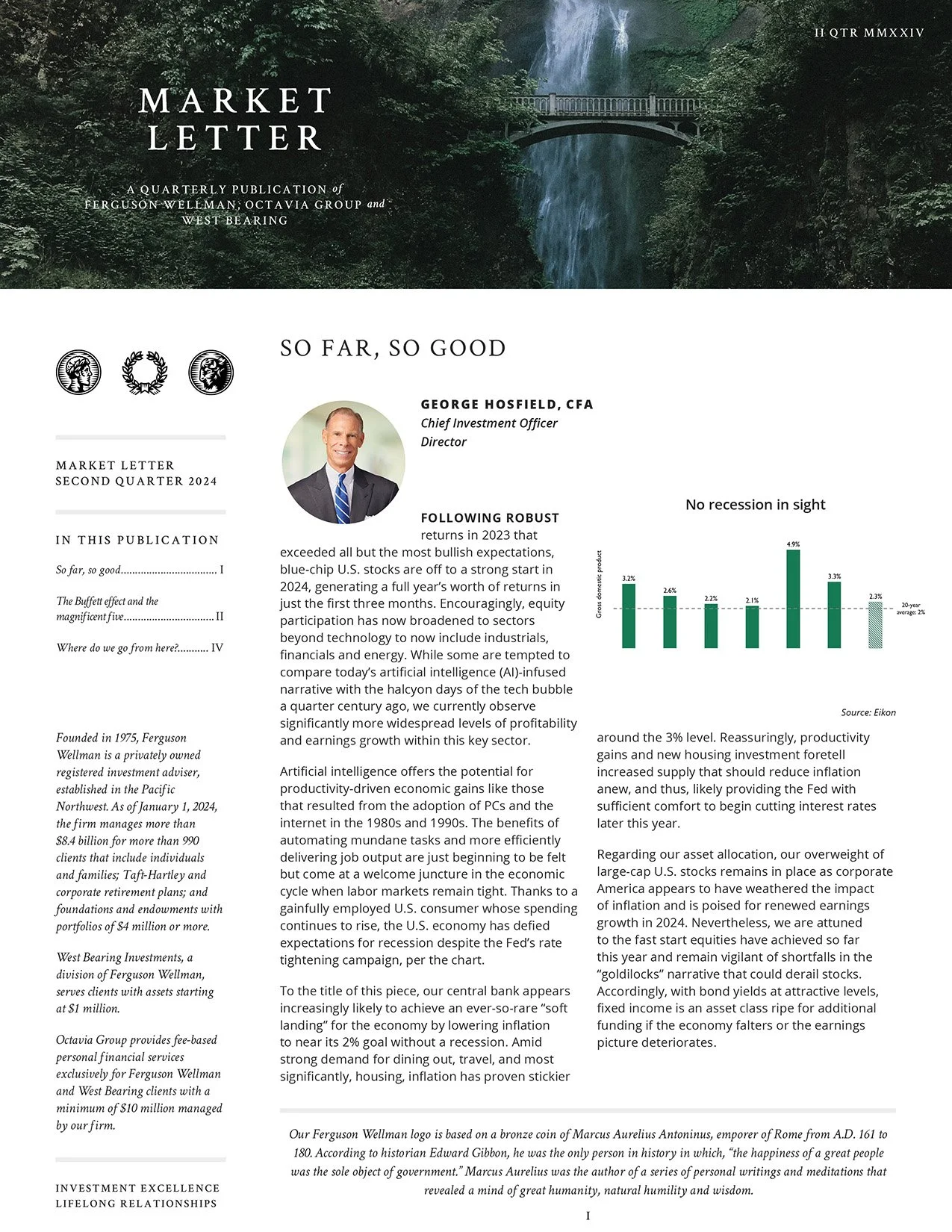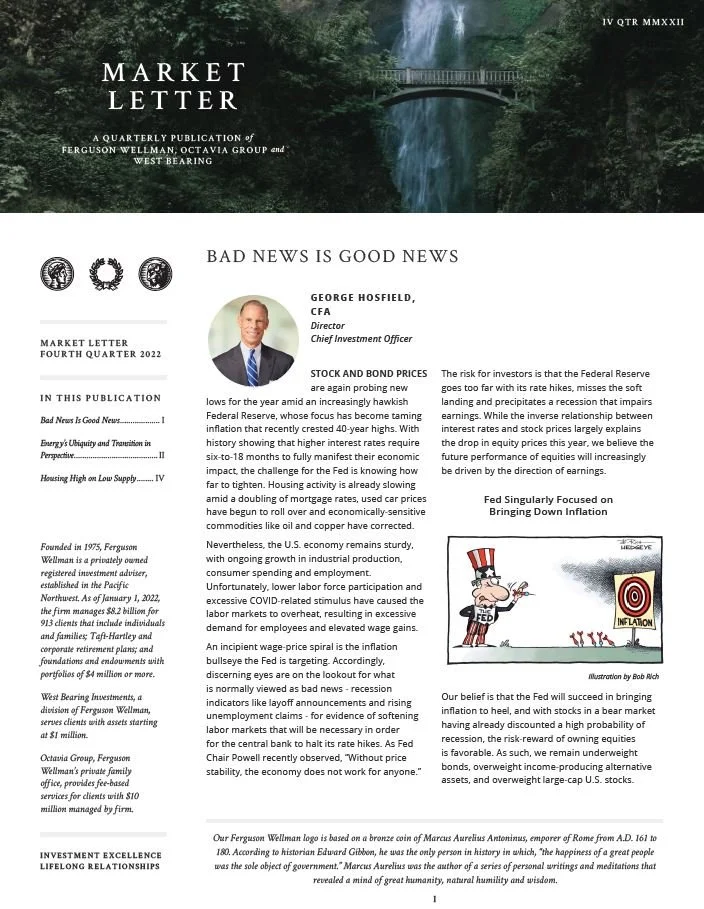Last week, over 28 million unique viewers tuned into the Games of the XXXIII Olympiad opening ceremony in Paris, France, double the combined state populations of Oregon, Washington and Idaho. The ceremony set the stage for the coming weeks of competition and allowed viewers to catch their first glimpses of the best athletes in the world. This week, investors were focused on a different stage: the Federal Open Market Committee (FOMC) press conference, which offered insight into the Fed’s future perspectives on inflation and employment.
Market Letter Third Quarter 2024
We present the third quarter 2024 Market Letter publication titled, “We’ve Landed,” featuring articles written by George Hosfield, CFA, Dean Dordevic and Joe Herrle, CFA.
Two Steps Forward, One Step Back
The first three weeks of the second quarter have been tough for both equity and bond investors. After a great start to the year, there hasn't been any place for investors to hide in April. The chart below highlights that the three major equity classes, as well as bonds, have all posted negative returns, with Small Caps now down close to 4% for the year.
Is 3% the New 2%?
The Consumer Price Index (CPI) is a measure of goods and services prices across the economy, and a popular gauge of inflation. The headline CPI rose 3.5% in March from a year earlier, which was higher than economists had forecast and an increase from February’s 3.2% reading. The Core CPI, which excludes the volatile food and energy components, also rose more than expected, with medical care and auto insurance boosting the non-housing service prices.
Market Letter Second Quarter 2024: So Far, So Good
We present Market Letter publication for the second quarter 2024 titled “So Far, So Good” in which Chief Investment Officer George Hosfield, CFA, outlines our belief the Fed remains on course to deliver an ever-so-rare soft landing to this inflationary cycle. Dean Dordevic writes about the Japanese economy and Warren Buffett’s investment there in recent years since the introduction of the “Corporate Governance Code” and Jason Norris, CFA, provides an update on equity market valuations and how investors expect the market to grow for the remainder of the year.
More Gas, Same Brakes
This past week’s plethora of economic and market-moving data, especially regarding interest rates, has served to highlight the sometimes-conflicting forces at work in the U.S. economy. While the Federal Reserve maintained their interest rate policy at 22-year highs on Wednesday, we also learned the U.S. government’s budget deficit grew to nearly $2 trillion in their most recent fiscal year.
Mixed Signals
Spooky season was in full force this week with contradictory messages from the economy versus the stock market. The week was chock-full of news with over 40% of the S&P 500 market capitalization reporting third quarter earnings, the release of third quarter economic growth, and finally, fresh data on the Fed’s preferred measure of inflation, the Personal Consumption Expenditure Index.
The Labor Market Holds the Key
The lead story from the stock market this year may well be the outperformance of a narrow and select group of technology companies, however the leading economic story this year may be the surprising resilience of the U.S. economy in the face of the Federal Reserve’s concerted effort to rein in growth via higher interest rates.
The Fed Holds Fast
This week, all eyes were on the inflation report and the subsequent Federal Reserve announcement a day later. Since these were the last announcements of their kind for 2022, market participants were paying close attention, with the hope of gaining some insight into what the rest of the year might look like for markets.
A December to Remember
As investors handicap the most anticipated recession in history, fourth quarter equity returns are playing out as expected. Historically, the fourth quarter, specifically the month of December, delivers the best results for equity investors. While this quarter has continued the positive trend, December is not acting as planned.
JOLT to the Job Market
Jerome Powell has the most difficult job in America. The Fed Chairman and the Federal Reserve Open Market Committee are tasked with lowering inflation and they primarily have only one blunt tool to accomplish this goal, adjusting interest rates.
Fourth Quarter 2022 Market Letter: Bad News Is Good News
Read our Market Letter publication for the fourth quarter 2022 titled, Bad News Is Good News, in which George Hosfield, CFA, Peter Jones, CFA, and Joe Herrle, CFA, share our thoughts on inflation, interest rates, the energy sector and housing supply in the United States.
The Funambulist Fed
This year has been anything but straightforward for investors, and the most recent Fed minutes are prolonging this state of confusion. While we have seen some reduced inflation pressure in the last several weeks, the Fed minutes point out that “risks to inflation were weighted to the upside,” citing factors such as further supply chain disruptions, continued geopolitical turmoil and persistent real wage growth. For investors, the focus continues to surround the pace of Fed rate hikes for the remainder of the year.
Mixed Reviews
This week, there was a plethora of economic and company-specific news for investors to digest. Specifically, the release of first quarter U.S. GDP, reported quarterly earnings by major technology companies and the unanimous vote by Twitter’s board to approve Elon Musk’s offer to take the company private. In response to this news, the market declined 4%, with all of the weekly losses occurring Friday afternoon.
Market Turbulence: Remain Focused on Long-Term Fundamentals
Some while ago as I was preparing for my first solo overseas flight, I told a friend in the aviation industry that I disliked turbulence; the stomach-churning drops and swings were too sudden and unpredictable for my appetite.
Are We There Yet?
“Are we there yet?” is a familiar back seat refrain that often occurs during long, summertime road trips involving bored children and their beleaguered parents. As we transition through our second COVID-affected summer, this frustration is also felt by investors and other market participants who long for some return to “normal.” Surely, we must all be there by now, right?
September Effect
For the fourth consecutive week, stocks posted negative returns with the S&P 500 trading near 3,220 for most of this week. Market technicians would view this as a technical support level or a base from which the market can work. At the current levels, the market can consolidate and take a breath to prepare for what is next.
Two Steps Forward, One Step Back
Economic data the past week reinforced the view that the U.S. economy continues to improve. This was highlighted by the retail sales number released by the U.S. Department of Commerce on Thursday morning.
The Calm Before the Storm?
Volatility returned to the markets this week with the S&P 500 declining by about one percent as investors followed political events in Washington, D.C. Interest rates were lower with the 10-year U.S. Treasury declining in yield from 2.36 percent to 2.22 percent.
To Beat or Not to Beat .... Expectations
 by Brad Houle, CFA
Executive Vice President
by Brad Houle, CFA
Executive Vice President
Today the Federal Reserve released the September change in nonfarm payrolls which came in at 142,000 jobs versus the estimate of 201,000 jobs. Also, August data was revised down from the originally reported 173,000 jobs to 136,000 jobs. This data was seen a disappointment and the bond market reacted negatively. According to Bloomberg data, the Federal Funds Futures Market, which is a market in which traders can speculate on the direction of the Federal Reserve raising interest rates, shows only a 2 percent probability of the Fed raising interest rates this month. The probability of the Fed to raise interest rates in December has dropped from a 40 percent probability early this month to a 29 percent probability as of today.
It is important to remember that the U.S. has created an average of 200,000 jobs for the last six months. Since the depth of the financial crisis, the unemployment rate has gone from over 10 percent to around 5 percent where it is today. We prefer to take the long view as opposed to changing opinion on every incremental piece of economic data. Payroll data is notoriously volatile and is a backward-looking indicator. U.S. consumer spending accounts for nearly 70 percent of our GDP or national income and continues to be robust despite a couple of months of job creation that does not meet expectations.
One of our research partners, Cornerstone Macro, published a note this morning with some facts about the U.S. consumer that are worth sharing:
- Consumer income growth has been a solid 4 percent for the past five years
- Real income expectations are rising for the first time in 20 years
- Consumer confidence is trending higher across all income levels
- Small businesses are having a hard time filling jobs
- Increasing construction spending is a major support to construction employment
- Increasing manufacturing construction is a support for manufacturing employment
- Average hourly earnings is in a rising trend for finance, business services, construction, health and education
- Auto sales came in at a seasonally adjusted annual rate of 18.2 million units, the most in more than 10 years
We still believe that the domestic economy and the U.S labor market are continuing to heal from the Great Recession. The headwinds from emerging market turbulence and a strong dollar are not large enough to derail this economic expansion.
Our Takeaways from the Week
- Job creation for September and the negative revisions for August did not meet economists’ expectations; however, the equity markets largely ignored the data finishing up modestly for the day
- The bond market reacted more with the 10-year Treasury bonds finishing the day below 2 percent























